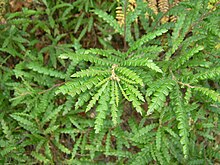Comptonia peregrina
| Sweetfern | |
|---|---|

| |
| Scientific classification | |
| Kingdom: | Plantae |
| Clade: | Tracheophytes |
| Clade: | Angiosperms |
| Clade: | Eudicots |
| Clade: | Rosids |
| Order: | Fagales |
| Family: | Myricaceae |
| Genus: | Comptonia |
| Species: | C. peregrina
|
| Binomial name | |
| Comptonia peregrina | |
| Synonyms[2][3][4] | |
| |
Comptonia peregrina is a species of flowering plant in the family Myricaceae native to eastern North America. It is the only extant (living) species in the genus Comptonia,[5] although a number of extinct species are placed in the genus.
Etymology
The common name is sweetfern or sweet-fern (although it is not a fern), or in Quebec, comptonie voyageuse.[3] The genus Comptonia is named in honor of Rev. Henry Compton (1632-1713), bishop of Oxford.
The species name peregrina literally means one that travels. Compare the plant's Quebec French name, comptonie voyageuse: "traveling comptonia."
Taxonomy
The species was first described, as Liquidambar peregrina, by Carl Linnaeus in 1753, in the second volume of Species Plantarum. Further on in the same volume, he described Myrica aspleniifolia as a different species (with the epithet spelt asplenifolia[note 1]). In 1763, he changed his mind concerning Myrica aspleniifolia, and it became Liquidambar aspleniifolia, and so in the same genus as Liquidambar peregrina.[6]
In 1789, Charles Louis L'Héritier placed Linnaeus's original Myrica aspleniifolia in his new genus Comptonia.[7]
In 1894, John M. Coulter transferred Linnaeus's Liquidambar peregrina to Comptonia, and treated Linnaeus's Myrica aspleniifolia as a synonym.[6] Comptonia peregrina is now the only extant (living) species in the genus.[5]
Description
Comptonia peregrina is a deciduous shrub, growing to 1.5 m (4.9 ft) tall. The leaves of the plant are linear to lanceolate, 3–15 cm (1.2–5.9 in) long and 0.3–3 cm (0.1–1.2 in) broad, with a lobed margin; they give off a sweet odor, especially when crushed. Plants are monoecious with separate unisexual flowers. The staminate flowers grow in clusters at the ends of branches, and are up to 5 cm (2.0 in) long. The pistillate flowers are only 5 mm (0.2 in), but elongate when the fruits form, reaching 5 cm (2.0 in).[3]
Distribution and habitat
Comptonia peregrina is native to eastern North America, from the Canadian provinces of Ontario and Quebec in the north, east to Nova Scotia, to extreme northern Georgia in the south, and west to Minnesota.[2] It tends to grow on dry sandy sites, and is associated with pine stands.[3]
Ecology
Comptonia peregrina is used as a food plant by the larvae of some Lepidoptera species, including Bucculatrix paroptila, grey pug, setaceous Hebrew character, Io moth, and several Coleophora case-bearers: C. comptoniella, C. peregrinaevorella (which feeds exclusively on Comptonia), C. persimplexella, C. pruniella and C. serratella. It is also a non-legume nitrogen fixer.
Uses and consumption
The plant produces a bristly burr that contains 1 to 4 edible nutlets.[8]
The aromatic leaves (fresh or dried) are also used to make a tea. The Canadian author Catharine Parr Traill includes it in her book The Female Emigrant's Guide in a list of substitutes for China tea. "When boiled," she notes, "it has a slightly resinous taste, with a bitter flavour, that is not very unpleasant." Mistaking it, like others, for a fern, she says that it is in high repute "among the Yankee and old Canadian housewifes (sic)."[9] Tea made from the plant has been said to treat the effects of poison ivy when applied to the affected area.[10] The plant has also been used as a seasoning.[11]
Notes
- ^ Article 60.10 of the International Code of Nomenclature for algae, fungi, and plants requires names not formed in accordance with the article to be corrected. The epithet aspleniifolia is formed from Asplenium and folia, so must be constructed as aspleni+i+folia.[12]
References
- ^ "Comptonia peregrina. NatureServe Explorer 2.0". explorer.natureserve.org. Retrieved 15 August 2023.
- ^ a b c "Comptonia peregrina (L.) Coult". Plants of the World Online. Royal Botanic Gardens, Kew. Retrieved 2019-07-18.
- ^ a b c d Bornstein, Allan J. "Comptonia peregrina". In Flora of North America Editorial Committee (ed.). Flora of North America (online). eFloras.org. Retrieved 2019-07-19.
- ^ "Liquidambar aspleniifolia (L.) L." The International Plant Names Index. Retrieved 2019-07-19.
- ^ a b "Comptonia L'Hér". Plants of the World Online. Royal Botanic Gardens, Kew. Retrieved 2019-07-18.
- ^ a b Coulter, John M. (1894). "Myricaceae". Memoirs of the Torrey Botanical Club. Vol. 5. pp. 127–128. Retrieved 2019-07-19.
- ^ "Comptonia aspleniifolia (L.) L'Hér". The International Plant Names Index. Retrieved 2019-07-19.
- ^ Peter Alden and Brian Cassie (1999). National Audubon Society Field Guide to the Mid-Atlantic States (1st ed.). Chanticleer Press. p. 130. ISBN 0-679-44682-6.
- ^ "The female emigrant's guide, and hints on Canadian housekeeping". Toronto Public Library. Retrieved 2018-01-17.
- ^ Brown, Jr., Tom (1986). Tom Brown's Field Guide: Wild Edible and Medicinal Plants. Berkley Books. p. 196. ISBN 978-0-425-10063-9.
- ^ "Comptonia peregrina - (L.)J.M.Coult". PFAF. Retrieved September 16, 2014.
- ^ Turland, N.J.; et al., eds. (2018). "Art. 60.10". International Code of Nomenclature for algae, fungi, and plants (Shenzhen Code) adopted by the Nineteenth International Botanical Congress Shenzhen, China, July 2017 (electronic ed.). Glashütten: International Association for Plant Taxonomy. Retrieved 2019-07-19.
External links
- USDA Plants Profile for Comptonia peregrina (sweet fern)
- Flora of North America: Comptonia peregrina
- "Comptonia peregrina". Germplasm Resources Information Network. Agricultural Research Service, United States Department of Agriculture.

